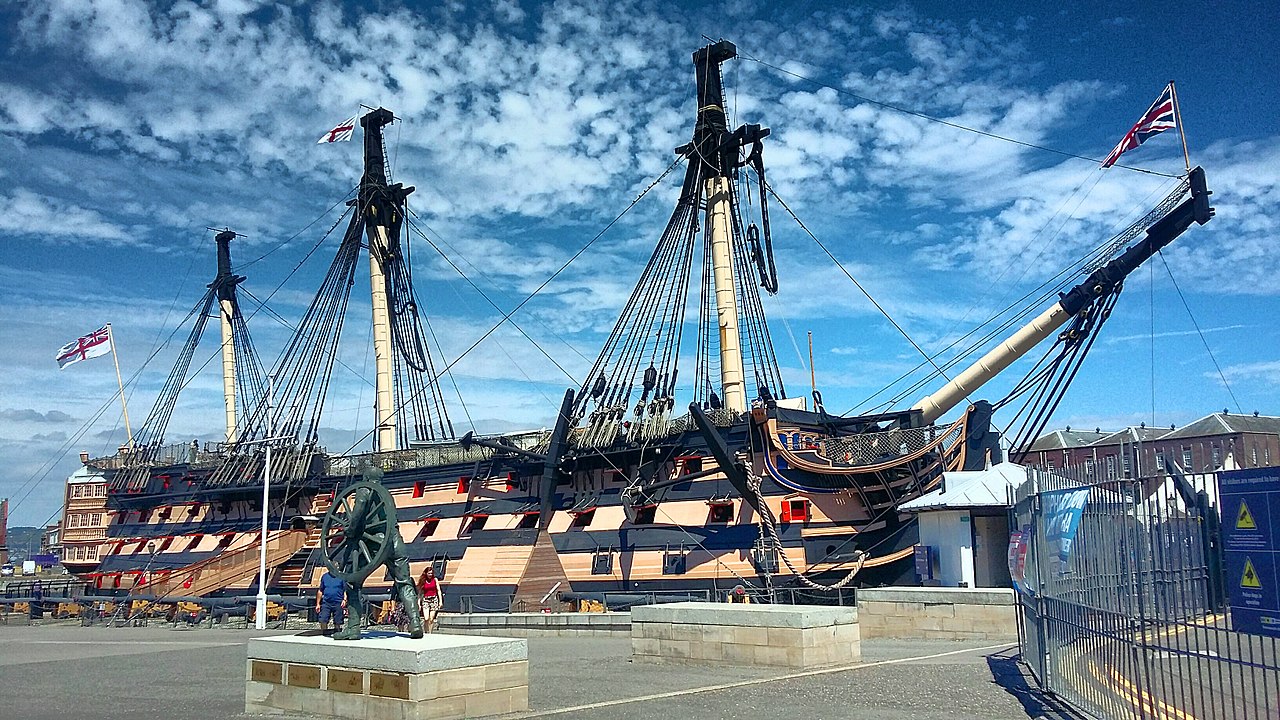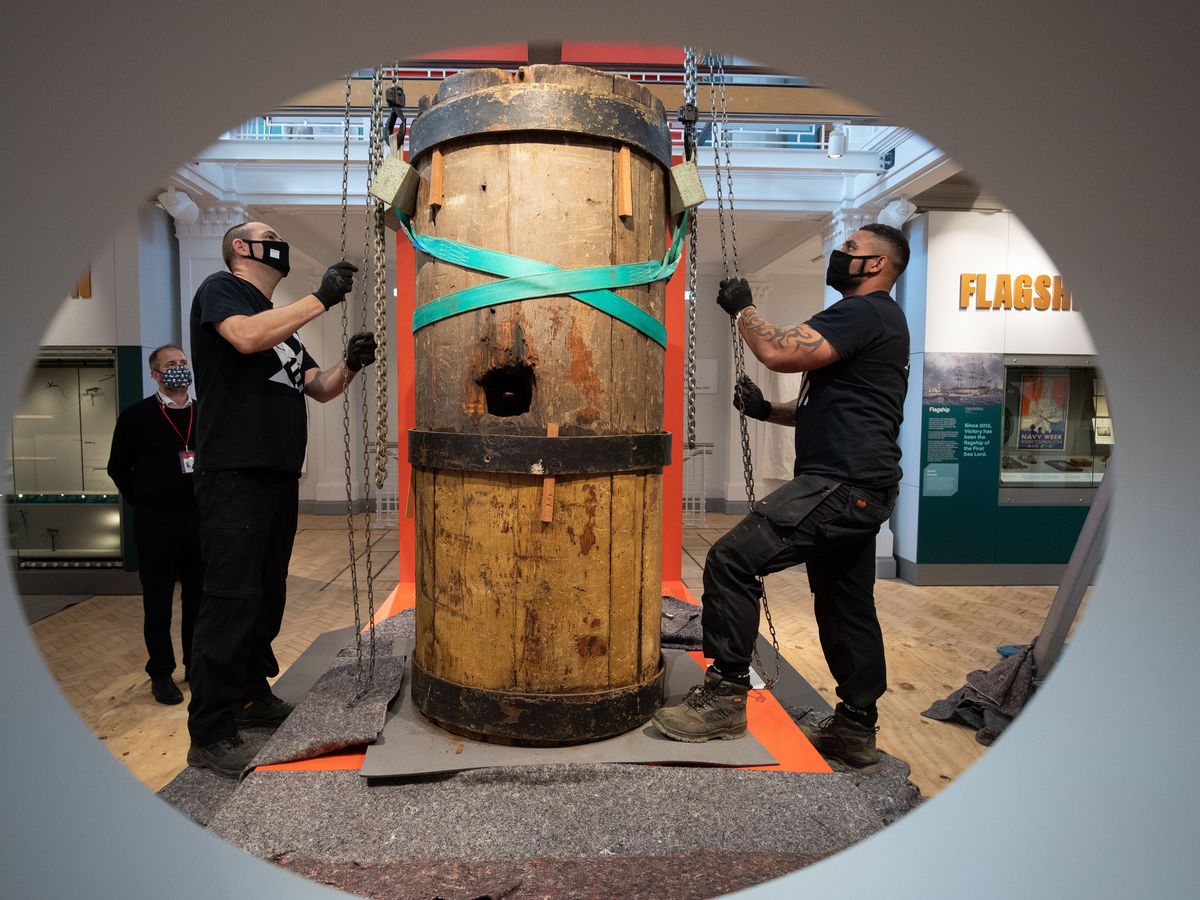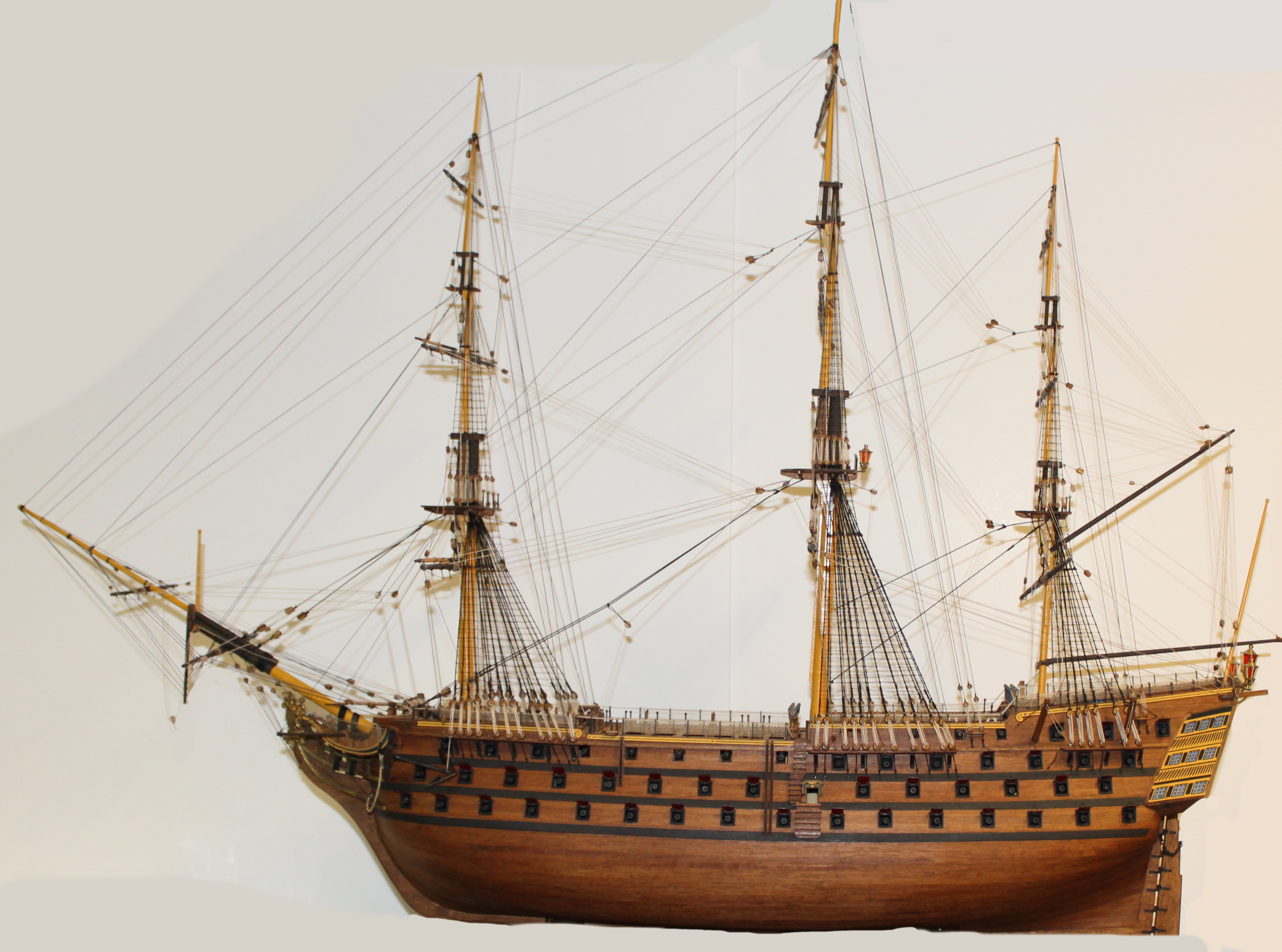
The HMS Victory is a "Ship of the Line" of the British Royal Navy. The HMS Victory was launched in 1765 and is best known for her role as Lord Nelson's flagship at the Battle of Trafalgar on 21 October 1805. She has been the flagship of the First Sea Lord since October 2012 and is the world's oldest naval ship still in commission, with 244 years' service as of 2022. The HMS Victory served in several battles including the First and Second Battle of Ushant, the Siege of Gibraltar, the Battle of Cape St Vincent, and Trafalgar. In 1807, the ship was downgraded to second line service, and was eventually transferred to dry dock in 1822. The ship narrowly escaped being disassembled and scrapped but was saved by an outpouring of public sentiment. Since that time, the ship has gone through multiple periods of decay and restoration. It was also damaged from a Luftwaffe bomb in 1941. Ownership of the ship was transferred from the Ministry of Defence to a dedicated HMS Victory Preservation Trust, established as part of the National Museum of the Royal Navy. Listed as part of the National Historic Fleet, Victory has been the flagship of the First Sea Lord since October 2012. Prior to this, she was the flagship of the Second Sea Lord. She is the oldest commissioned warship in the world and attracts around 350,000 visitors per year in her role as a museum ship. A Ship of the Line is a type of naval warship designed to operate in Line of Battle. The is a scenario in which two columns of opposing warships maneuver to volley fire with the cannons along their broadsides. The ship with the most firepower had the advantage. The Ship of the Line concept was prevalent during the 17th century to the mid-19th century. The standard design for these ships employed two, three of four decks of guns.

The HMS Victory is essentially a floating gun platform designed to carry cannons for engaging in naval combat. Construction of the Victory took seven years and cost the equivalent of 65 million US dollars. The Victory was designed by Thomas Slade of the Royal Navy and built at the Chatham Dockyard in England. 250 men were required to harvest over 100 acres of oak forest to harvest wood for the structure. The keel and the frame was built in 1759. The largest oak trees were used to create the 30 ft tall stern posts. The Victory is a rigged ship vessel with three masts and a bow sprit.

Each of the masts were made from seven trees joined tightly with iron hoops and hundreds of feet of rope. The masts required twenty miles of rigging and carried four acres of sails.

Two tons of copper and iron nails were required for construction of the deck. The ship has 37 sails with a total surface area of 6,500 yards. The sails were mounted on horizontal yards arms mounted on the four masts. Over 120 men were required to operate the sails. The HMS Victory required 7 anchors of various sizes, the largest of which weighed 4 tons. Raising this largest anchor required about 140 men. The Victory's hull was covered with almost 4,000 sheets of copper plate to protect the wood from saltwater clams.

The HMS Victory was armed with over 100 smooth bore muzzle loaded cannon which could fire solid shot, and two types of shrapnel shot for destroying enemy ship structures or use as anti-personnel munition. The cannons were fired sequentially from bow to stern to keep the ship from listing. Each cannon weighed about 1500 pounds and required a crew of 12. A properly trained crew could fire a full broadside every 90 seconds.
Battle of Ushant:
The First Battle of Ushant took place on July 27th, 1778 and was fought during the American Revolutionary War between British and French Fleets. Ushant is and island at the mouth of the British Channel of the north western most point of France.The battle was the first naval engagement of the war and ended with indecisive results. The French and the British each had about 30 ships commited to the battle. "The battle began at 11:20 when the fourth French ship in the line was able to bring her guns to bear. Keppel, who wished to save his salvo for the enemy flagship, received the broadsides of six French ships without reply. Once he had engaged the 110-gun Bretagne, he continued to attack the next six ships in the French line. As the British van under Robert Harland passed the end of the French line, Harland ordered his ships about so as to chase the French rearguard, including the Sphinx. Palliser's ten ships at the rear had not formed line of battle but were instead in a loose irregular formation. This was in part due to Keppel's earlier order to break off and chase the French ships to windward. Palliser's division therefore was badly mauled, having allowed itself to be attacked piecemeal. At 1p.m. Victory passed the last French ship and attempted to follow Harland but was so badly damaged in the masts and rigging that Keppel had to wear round and it was 2p.m. before his ships were on the opposite tack. It was about this time that Palliser in Formidable emerged from the battle, downwind of Keppel's division. Meanwhile, the French line had tacked and was now heading south on the starboard tack and threatening to pass the British fleet to leeward. The French practice of firing high into the rigging had left several of the British ships disabled and it was this group that Keppel now stood down towards whilst making the signal, 'form line of battle'. By 4p.m., Harland's division had gone about and joined Keppel's ships in line but Palliser would not or could not conform and his ships, misunderstanding Keppel's intentions, formed line with their commander, several miles upwind from the rest of the British fleet. D'Orvilliers did not however attack the British fleet while it was divided into three sections but instead continued his course, passing the British fleet to leeward.At 5p.m., Keppel sent the sixth-rate, HMS Fox to demand that Palliser join the main body of the fleet and when this failed, at 7, Keppel removed Palliser from the chain of command by individually signalling each ship in Palliser's division. By the time those ships had joined Keppel, night had fallen and, under cover of darkness, the French fleet sailed off. By daylight the French were 20 miles away and with no chance of catching them, Keppel decided to return to Plymouth to repair his ships."
The Seige of Gibralter:
"In October 1782, Victory under Admiral Richard Howe was the fleet flagship of a powerful escort flotilla for a convoy of transports which resupplied Gibraltar in the event of a blockade by the French and Spanish navies. No resistance was encountered on entering the straits and the supplies were successfully unloaded. There was a minor engagement at the time of departure, in which Victory did not fire a shot. The British ships were under orders to return home and did so without major incident"
The Battle of Cape St Vincent:
"In 1796, Captain Robert Calder (First Captain) and Captain George Grey (Second Captain), commanded Victory under Admiral Sir John Jervis’s flag. By the end of 1796, the British position in the Mediterranean had become untenable. Jervis had stationed his fleet off Cape St Vincent to prevent the Spanish from sailing north, whilst Horatio Nelson was to oversee the evacuation of Elba. Once the evacuation had been accomplished, Nelson, in HMS Minerve, sailed for Gibraltar. On learning that the Spanish fleet had passed by some days previous, Nelson left to rendezvous with Jervis on 11 February. The Spanish fleet, which had been blown off course by easterly gales, was that night working its way to Cadiz. The darkness and a dense fog meant Nelson was able to pass through the enemy fleet without being spotted and join Jervis on 13 February. Jervis, whose fleet had been reinforced on 5 February by five ships from Britain under Rear-Admiral William Parker, now had 15 ships of the line. The following morning, having drawn up his fleet into two columns, Jervis impressed upon the officers on Victory’s quarterdeck how, “A victory to England is very essential at the moment”. Jervis was not aware of the size of the fleet he was facing, but at around 0630 hours, received word that five Spanish warships were to the south-east. By 0900 hours the first enemy ships were visible from Victory’s masthead, and at 1100 hours, Jervis gave the order to form line of battle. As the Spanish ships became visible to him, Calder reported the numbers to Jervis, but when he reached 27, Jervis replied, “Enough, Sir. No more of that. The die is cast and if there are 50 sail, I will go through them”. The Spanish were caught by surprise, sailing in two divisions with a gap that Jervis aimed to exploit. The ship’s log records how Victory halted the Spanish division, raking ships both ahead and astern, while Jervis’ private memoirs recall how Victory’s broadside so terrified Principe de Asturias that she “squared her yards, ran clear out of the battle and did not return”. Jervis, realising that the main bulk of the enemy fleet could now cross astern and reunite, ordered his ships to change course, but Sir Charles Thompson, leading the rear division, failed to comply. The following ships were now in a quandary over whether to obey the Admiral’s signal or follow their divisional commander. Nelson, who had transferred to HMS Captain, was the first to break off and attack the main fleet as Jervis had wanted and other ships soon followed his example. The British fleet not only achieved its main objective, that of preventing the Spanish from joining their French and Dutch allies in the channel, but also captured four ships. The dead and wounded from these four ships alone amounted to 261 and 342, respectively; more than the total number of British casualties of 73 dead and 327 wounded. There was one fatality aboard Victory; a cannonball narrowly missed Jervis and decapitated a nearby sailor."
The Battle of Trafalgar:
" The naval campaign began as part of Napoleon Bonaparte's plan to invade Britain in the summer of 1805. Napoleon needed to gain control of the English Channel to allow his Grand Armée to cross. To achieve this he ordered the French fleet's three squadrons blockaded at Brest, Toulon and other ports to break out, meet in West Indies and then return as one fleet to gain control of the Channel. In March the squadron of Admiral Villeneuve at Toulon was able to evade the British blockade, joined up with a Spanish squadron and left for the West Indies. Nelson learned of his departure on 10 April and was soon in hot pursuit. Villeneuve lost his nerve and immediately returned to Europe. After a minor battle off Cape Finisterre he was bottled up in Cadiz in Spain. Recognising that the invasion was now impossible, Napoleon marched his Grand Armée to meet the threat posed by Austria and Russia in the east. Nelson's fleet of 27 ships of the line now waited for Villeneuve's force to emerge. The fleet was a high peak of fighting efficiency having been at sea blockading the French for almost two years. At the end of September, Nelson revealed his plan to his captains; the fleet would be split into two columns to break through the enemy line and overwhelm the centre and rear sections of the enemy's fleet. On 19 October a British frigate watching Cadiz spotted the Franco-Spanish fleet leaving harbour. It consisted of 33 ships of the line including the 136 gun Santissima Trinidad, the largest ship in the world. Villeneuve's orders were to try to break into the Mediterranean. The message was passed to Nelson's fleet, 48 miles off the coast and he ordered a general chase. By dawn on 21 October the British fleet was only 9 miles away from the enemy. At 1148 HMS Victory hoisted the famous signal 'England Expects That Every Man Will Do His Duty' followed by 'Engage the enemy more closely'. The two columns led by HMS Victory and HMS Royal Sovereign successfully pierced the enemy line firing into the bow and stern of enemy ships as they passed between them. The fighting was severe and much of it was at close quarters. Many of the British ships were damaged, some seriously, including the HMS Victory which engaged the French flagship Bucentaure and the Redoutable. But Nelson's faith in the superior gunnery and ship handling skills of the British crews was fully borne out with the capture of 18 enemy ships including the Santissima Trinidad. Villeneuve had surrendered at 13.45 and despite renewed resistance by some Spanish ships the battle was over by 16.30. A great storm blew up on 22 October and when it subsided only four enemy ships remained in British hands most having sunk. The total number of killed and wounded on both sides was about 8,500 whilst the British took about 20,000 prisoners. Nelson himself had been shot by a musket ball at about 13.15 and died around 16.30 when victory was assured. The era of British naval supremacy brought about by the victory at Trafalgar lasted for a century until Germany's naval challenge in the first decade of the Twentieth Century."



